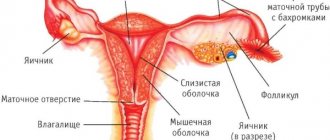In many developing countries, which, unfortunately, includes ours, abortion still continues to be one of the most widespread ways to prevent unwanted pregnancy. But why does this happen? Either this is a lack of basic sex education, or an absolutely disregard for one’s health, or echoes of old Soviet statements like “there is no sex in our country,” which prevent parents from telling their children correctly and without shame about the rules of safe sexual behavior. But still, most likely there is an influence of all the above factors in combination.
According to statistics, abortion leads to infertility in every fifth woman. Even if you do not take into account the enormous number of other complications that arise after and during an abortion, the risk of infertility should be quite enough to make you wonder if the gamble is “worth the candle.”
Modern medicine offers a huge arsenal of ways to protect against unwanted pregnancy. In order not to regret what you did in the future (we mean abortion), you just need to decide on the method of contraception that is suitable for you personally.
Let's start with the reliability of existing methods.
Reliability of contraceptive methods:
| Method of contraception | Degree of reliability |
| Interrupted sexual intercourse | 80% — 85% |
| Calendar method (safe days method)* | 80% — 90% |
| Basal temperature measurement method* | 80% — 90% |
| Vaginal douching | 10% — 15% |
| Condom | 90% — 95% |
| Diaphragm (vaginal cap) | 90% — 95% |
| Intrauterine devices (spirals) | 90% — 92% |
| Hormonal intrauterine devices (spirals) | 90% — 97% |
| Chemical contraception (creams, suppositories, tampons) | 79% — 90% |
| Hormonal pills (oral contraception) | 96,5% — 97% |
| Hormonal injections | 96,5% — 97% |
| Hormonal implants | 99% — 99,8% |
| Hormonal ring NuvaRing | 99% |
| Hormonal contraceptive patch Evra | 99,4% |
| Medical sterilization | 99,8% — 99,9% |
| Emergency postcoital contraception | — |
* this degree of reliability is only possible with a regular menstrual cycle.
Natural methods of contraception
Methods of preventing unwanted pregnancy without hormones have been used for a long time. Despite the wide range of modern contraceptives offered by pharmacists, they still remain relevant today.
One of them is based on counting the days of ovulation. On average, the duration of the menstrual cycle is from 28 to 30 days. In its first half, the follicle matures. And ovulation occurs in the second half of the cycle. The ability to fertilize a mature egg remains for 2-3 days. In this case, sperm can take a wait-and-see position for 4 days. Therefore, special care only needs to be taken for about a week in the middle of the cycle.
In some cases, the days of ovulation can be determined by measuring basal temperature, which rises on the most dangerous days. However, the reliability of calculations and temperature measurements in the rectum cannot guarantee full protection.
Some couples practice coitus interruptus. However, even in this case, pregnancy cannot be ruled out, since a small amount of sperm may be contained in the lubricant secreted by the partner’s penis. In this case, the likelihood of pregnancy increases depending on how many sexual acts have been performed.
Coitus interruptus
The correct technique for using this method is as follows: the man must remove the penis from the woman's vagina immediately before ejaculation (ejaculation). Ejaculation itself can occur anywhere, but not in a woman’s vagina.
The popularity of this method of preventing unwanted pregnancy is understandable. It does not require material costs and does not reduce the sensitivity of the partners’ genitals during intercourse. However, it has much more negative sides than positive ones. Firstly, the method is very unreliable. This is explained by the fact that the “lubricating” (pre-seminal) fluid that is released from a man during sexual intercourse contains from 10 to 20 million sperm, which is more than enough to fertilize an egg. And even if you are sure that your partner has excellent control over the process of ejaculation, then no man can control the release of “lubricating” fluid (except perhaps a few yogis in distant India, and even then it’s unlikely). Secondly, long-term use of this method of contraception negatively affects the psychological state of partners, since interruption of sexual intercourse is not physiological. Many studies have proven that a regular lack of natural satisfaction can lead to sexual coldness in women, impotence in men and a sharp decrease in sexual desire in both partners. Thirdly, interrupted sexual intercourse will never protect you from sexually transmitted diseases, as well as AIDS and viral hepatitis. Therefore, it is unacceptable to use this method for casual sex.
Surgical methods
You can protect yourself from unwanted pregnancy after sexual intercourse using radical methods. This is surgical sterilization, which is an irreversible operation. During the operation, the spermatic cords in men and the fallopian tubes in women are cut.
This method will protect against unnecessary pregnancy after the birth of two or more children; it is usually chosen by older couples when conception is absolutely undesirable. In Russia, this method of sterilization is legally allowed to be used after 35 years.
Traditional methods
Prevention methods at home are still very popular. The effectiveness of such methods has been proven over many years of use, when medical treatments simply did not exist.
Preventing pregnancy with folk remedies is completely safe. The following techniques were used:
- inserting a piece of lemon into the vagina. An acidic environment has a detrimental effect on sperm, preventing them from reaching the uterus;
- douching before sexual intercourse with a solution of citric acid, aspirin, potassium permanganate. The acidity in the vagina changes, sperm lose their mobility;
- taking a loading dose of vitamin C, which can change the egg development cycle, bringing menstruation closer and preventing conception.
Folk remedies also include teas made from shepherd's purse, marjoram and ginger root. They can be protected by such means only when taking such teas regularly, drinking a glass of the decoction three times a day.
Contraceptives to prevent pregnancy after 45 years are of particular relevance. Various pathologies accumulate in the body and you need to act very carefully.
Doctors do not recommend using traditional methods to prevent pregnancy, noting their low effectiveness. But we must not forget that girls have been using such remedies for centuries, and doctors make money by selling medications.
Efficiency of various methods
There are medical statistics on the percentage of unplanned conceptions with various methods of contraception during the year. It reflects their effectiveness in achieving the goal. In descending order of effectiveness, the methods are arranged in the following order:
- lack of sexual intercourse;
- Navy;
- injectable hormonal implants;
- hormonal patch;
- combination tablets;
- vaginal diaphragm;
- condoms;
- calendar method;
- interrupted sexual intercourse;
- spermicides;
- lack of contraception.
Calendar method ("safe days" method)
The calendar method belongs to the group of natural methods for preventing unwanted pregnancy. The essence of the method is that a woman is capable of conceiving only for several days after the release of the egg from the ovary (ovulation) - that is, during the life of the egg. Theoretically, ovulation occurs in the middle of the monthly cycle - approximately on days 11-15. It is this period of time that is considered favorable for conception, and the rest of the time a woman is not capable of conceiving. But this is only theoretical. A regular 28-day menstrual cycle with ovulation in the middle occurs in only 30% of women. And this is the exception rather than the rule. It is also necessary to take into account that sperm in a woman’s vagina can remain viable for up to 9 days. And if ovulation occurs during this period, then rest assured that they will not miss their goal. The calendar method is very “labor-intensive”, since in order to correctly count safe days, a woman must be aware of any changes in her menstrual cycle, that is, regularly keep records for at least the last year. Agree, not every woman is capable of such a feat.
But let's not talk about sad things, since nothing is impossible in our life. And if you really want to use this method of contraception, then use it. Its effectiveness directly depends on your organization and the presence of basic mathematical skills.
How do you still calculate “safe” days?
Firstly, it is necessary to clearly understand that the first day of the menstrual cycle is considered the day the menstruation (discharge) begins. The last day is the first day of the next and nothing else.
For clarity and ease of counting the days you are interested in, create a table. In the first column, indicate the month, in the second, the start date of the menstrual cycle, and in the third, its duration.
| Month | Date of the first day of the cycle | Cycle duration |
| January | 10 | — |
| February | 7 | 28 |
| March | 5 | 26 |
| April | 1 | 27 |
| May | 1 | 30 |
| June | 29 | 28 |
| July | 27 | 29 |
| August | 27 | 30 |
| September | 24 | 28 |
| October | 21 | 28 |
| November | 18 | 27 |
| December | 13 | 29 |
In this case, the table data shows that the shortest cycle is twenty-six days (March), and the longest is thirty days (August). That is, there is no clear regularity in the duration of the menstrual cycle.
In a short (26-day) cycle, ovulation occurs approximately fourteen days before the start of menstruation - on the 12th day of the cycle. Taking into account possible deviations in the onset of ovulation within 3 days in one direction or another, we can conclude that the period of possible conception in each cycle of the specified duration ranges from the 9th to the 15th day.
In a long (30-day) cycle, ovulation also occurs 14 days before menstruation, that is, on the 16th day. Possible three-day deviations are not going away and they also need to be taken into account. In this case, the period of probable conception ranges from the 13th to the 19th day of the menstrual cycle.
Even with such slight variability in the menstrual cycle (the difference between the duration of the longest and shortest cycles is only 4 days), it becomes impossible to predict the duration of the next one. Therefore, the woman in the example we described should assume that ovulation can occur between days 9 and 19 of the cycle. And if we additionally take into account the viability of sperm and possible re-ovulation during active sexual life, then there will be practically no “safe” days left.
Therefore, we repeat: effective use of this method of contraception is possible only with a regular menstrual cycle with a predictable time of ovulation.
Basal temperature measurement method
This method also refers to natural methods of planning pregnancy. Its essence is as follows. Before ovulation, the basal temperature is kept at a lower level due to the action of estrogen; after ovulation, progesterone raises the temperature to a higher level. A rise in basal temperature means that ovulation has already occurred.
When measuring basal temperature, you must adhere to several rules:
- It is necessary to measure the temperature at the same time every morning, without getting out of bed
- Temperature should be measured throughout the entire cycle, including during menstruation
- the duration of the measurement should be the same each time (for example, when using a regular glass thermometer - 5 minutes)
- Throughout the entire cycle you need to use the same thermometer.
The standard type of temperature rise clearly shows a level of low temperatures, then a sharp rise of at least two tenths of a degree, followed by a level of high temperatures that remains until the end of the current cycle. The difference between the average temperature of the second and first phases of the menstrual cycle should be at least 0.4-0.5 degrees.
The effectiveness of this method increases when used in combination with the calendar method described above.
Disadvantage
All of the above methods of natural protection from unwanted pregnancy, in addition to their low effectiveness, also have a high risk of contracting sexually transmitted diseases, AIDS and viral hepatitis.
Features of taking pills
How long can you take oral contraceptives, and do you need to change them? They must be taken daily and preferably at the same time. It is recommended to start taking them on the first day of menstruation. These drugs are intended for long-term use. However, women taking hormonal contraceptives should visit their gynecologist annually. If there are no contraindications, you can continue taking contraceptives.
With long-term use of COCs, menstruation may stop altogether, and this is not a pathology. However, if a woman forgot to take her birth control pill and the last day of her period is long past, this may be a sign of pregnancy. After discontinuation of contraceptives, the menstrual cycle is completely restored within 1-2 months. In this case, pregnancy can occur immediately or after a short period of time. You can take birth control pills for several years. If they do not cause any side effects in a woman, they should not be changed. Otherwise, the body will experience stress.
Vaginal douching
The essence of this method is to expose the sperm already present in the woman’s vagina to various chemicals that can kill them. Various antiseptics are often used, for example, miramistin, chlorhexidine and others. In fact, these substances are not able to protect you from unwanted pregnancy due to the fact that, one: sperm are extremely mobile, two: there are unusually many of them, three: they know how to hide in the mucus of the cervical canal, which makes them inaccessible to disinfectants.
It is the above reasons that determine the low efficiency of this method.
It is also necessary to remember that frequent exposure of the vaginal mucosa to drugs that are aggressive towards microorganisms leads to disruption of the normal composition of the microflora and the subsequent development of a condition called dysbiosis. At the same time, the woman’s reproductive system is populated by microorganisms that are normally either very small or should not exist at all (for example, fungi of the genus Candida).
The difficulty of choosing contraceptives
https://www.youtube.com/watch?v=VTVp8XaRsTc
Who should decide how to protect a woman from unwanted pregnancy? Ideally, this should be done by the woman herself, after first listening to the opinion of a specialist. It is worth noting that in many countries, people's opinions are strongly influenced by cultural norms and traditions. For example, in China, intrauterine devices are used tens of times more often than any other type of contraception.
Oddly enough, most girls and women from the CIS countries often immediately limit themselves in their choice. They tend to ask very specific questions about how to protect themselves from unplanned pregnancy without pills and IUDs. However, the choice of a particular method of contraception should primarily be based on the following principles:
- Efficiency.
- Safety.
- Side effects.
- Applicability.
- Availability of additional properties.
In Japan, less than 1% of women of fertile age use birth control pills, while in Austria the figure reaches almost 40%.
When choosing the optimal method of contraception, it is necessary, first of all, to take into account whether a woman wants to have a child in the future or not.
Condom
The mechanism of action of a condom as a means of contraception is to create a mechanical barrier for the penetration of sperm into the vagina. Therefore, the complete ineffectiveness of using this means of protection is observed only when it is damaged. It should be borne in mind that the resulting defect can be quite small and is often almost impossible to notice.
To reduce the risk of damage to the condom during its use, you must follow certain rules. Firstly, you should not roll out the condom before putting it on the penis; secondly, do not try to check its integrity in any way (for example, by inflating or filling with water), as this significantly increases the risk of damage; thirdly, you should not simultaneously with condoms, use additional oil-based lubricants, as they can reduce the strength of latex - it is permissible to use only water-based lubricants; fourthly, you must strictly follow the instructions for using the condom.
Remember that proper use of a condom will not only protect you from unwanted pregnancy in 90% - 95% of cases, but will also reduce the risk of contracting sexually transmitted diseases by 90%.
For confident use, it is recommended to purchase condoms from well-known manufacturers and only at a pharmacy where their storage conditions are observed. It is also recommended to pay attention to the expiration date of the product.
Diaphragm (vaginal cap)
The diaphragm is the female version of the condom. It also consists of the finest latex. Before using a vaginal cap, it is necessary to consult a gynecologist, since the effectiveness of using a diaphragm directly depends on the correct choice of its size, which must clearly correspond to the size of the vagina and cervix. The vaginal cap, like a condom, creates a mechanical obstacle to the path of sperm, but, unlike the latter, does not protect against sexually transmitted diseases.
A negative aspect of this method of contraception, in addition to its inability to protect against infections, is also the need to correctly install the cap in the vagina. Agree that not every woman will be able to do this correctly the first time.
Spirals
There are several types of IUDs that protect against pregnancy. They may vary in shape, hardness and duration of action.
Spirals are divided into two large groups based on material – plastic and metal. The first type is capable of causing an immune reaction of the endometrium, and the second type has a spermicidal effect. The second type of spirals is most effective. Copper is most often used for metal structures.
A separate group consists of hormonal IUDs, which not only prevent conception, but also eliminate pain during menstruation.
The advantage of this type of contraception is the direct local effect and the absence of many adverse reactions that cause oral medications.
Among the disadvantages of this method is the inability to protect against sexually transmitted infections.
Intrauterine devices (spirals)
The contraceptive effect of the IUD is due to the following. The leg of the intrauterine device consists of copper, which, when released into the uterine cavity, creates an environment that is impossible for sperm and eggs to exist. Copper also provokes the development of a local aseptic (without the participation of pathogens) inflammatory reaction, which, in turn, does not allow sperm and eggs to function fully. The effectiveness of this method of contraception is on average 80%.
Like any method of preventing unwanted pregnancy, the use of an IUD has positive and negative sides.
Let's start with the positive
sides:
- The IUD begins to act immediately after insertion and does not require the use of additional methods of contraception;
- Installation of an IUD implies a long-term contraceptive effect (up to 6 years) and the IUD is often removed not because its expiration date, but more often because of the woman’s desire to become pregnant;
- The ability to conceive is restored immediately after the IUD is removed from the uterine cavity.
To the negative
The aspects of using an IUD include the following:
- The presence of a foreign body in the uterine cavity is always an open entrance for infection;
- When using this method of contraception, regular (at least once every six months) examination by a gynecologist is necessary;
- The presence of an IUD can cause an increase in the abundance of menstrual flow, as well as provoke its pain;
- IUDs do not protect against sexually transmitted diseases;
- The use of an IUD is not recommended for nulliparous women.
Also, before using the IUD, it is necessary to consult a gynecologist who will determine the presence of contraindications to inserting the IUD (for example, the IUD cannot be installed if a woman has any genital infection).
One of the most unpleasant consequences of using this method of contraception is the increased risk of developing an ectopic pregnancy after removal of the IUD. Many studies have proven that the risk of ectopic pregnancy in women who used IUDs is 4 times higher.
How to protect yourself from pregnancy.. Surgical contraception
Male sterilization (vasectomy)
A vasectomy is a simple surgical operation that involves cutting the vas deferens. Does not affect the ability to have intercourse and sensations during it.
- In the first 5, maximum 10 years, a reverse vasectomy can be performed, but the patency of the vas deferens is rarely restored.
- After a vasectomy, it is important to take a spermogram, since sperm may still be present in the ejaculate for a quarter after the operation.
The Pearl index, provided that a spermogram was performed a quarter after the operation, is less than 1. Without sperm analysis, the indicator is 2-3.
Female sterilization (tubal occlusion)
The so-called “tubal ligation” is a voluntary, most often laparoscopic operation, as a result of which the patency of the fallopian tubes is disrupted.
- There are several methods of performing the operation: intersection, excision, ligation, blockage, application of special clamps to the fallopian tubes.
- Theoretically, when using the clamp method, the ability to conceive can be restored, but in practice, the passage of the egg through the tubes after removal of the obstruction is poorly restored.
- It is impossible to restore the patency of the crossed fallopian tubes; pregnancy will only be possible through IVF.
- Sterilization does not affect libido, hormonal system, or psyche.
Hormonal intrauterine devices (spirals)
Hormonal intrauterine devices differ from regular ones in that, in addition to the copper component, they also contain the hormone levonorgestrel, which prevents pregnancy. That is, the action of the hormone is added to the effect of local inflammation, which determines the higher effectiveness of the method compared to the use of conventional spirals.
There are no fundamental differences in contraindications, positive and negative effects of the hormonal IUD compared to the use of a regular one. The only thing a woman needs to know is that the ability to conceive after removal of the hormonal IUD can take a longer time to recover. So, 6 months after its removal, pregnancy occurs in 50% of women, and after a year, almost all women are already capable of conceiving (98%).
Chemical contraception (creams, suppositories, tampons)
Chemical contraception combines several effects: contraceptive, antimicrobial and antiviral. These drugs contain antiseptic substances that actively affect both sperm and pathogens of infectious diseases, including viruses. But, unfortunately, using this method in mono mode (without the parallel use of other means) is not always effective.
When using them, it is necessary to remember that the acid, which is what chemical contraceptives are, is neutralized when interacting with alkali, which causes a decrease in the effect until it disappears completely. That is why you should not use soap before and after sexual intercourse using chemical contraception (soap has an alkaline reaction).
Again, it is known from practice that the duration of action of candles and creams is much shorter than the manufacturer claims on the packaging. Therefore, before the next sexual intercourse (even if it occurs a short period of time after the previous one), it is recommended to introduce a new suppository or portion of cream. This nuance does not apply to contraceptive tampons. Their action lasts from 12 to 16 hours.
This method is convenient for women who are breastfeeding, since the substance contained in the contraceptive has only a local effect and does not enter the bloodstream, and, accordingly, into breast milk.
A negative consequence of frequent use of chemical contraception (as well as with douching) is a disruption of the normal composition of the vaginal microflora with the formation of dysbacteriosis.
Hormonal pills
This method of contraception was discovered not so long ago, but its appearance opened a new era in solving the problem of protection from unwanted pregnancy. The essence of hormonal contraception is to prevent ovulation - the release of a mature egg from the ovary. And if the egg does not appear in the field of vision of the sperm, then they sit idle, unable to fertilize it.
The effectiveness of hormonal contraception when used correctly is close to 100%, but it must be remembered that the use of hormonal pills does not protect you from sexually transmitted diseases.
The impact of contraception on health
Every adult must know how to protect themselves from unwanted pregnancy. Active use of contraception as a method of family planning is an important factor in reducing the number of abortions and associated health risks.
Hormonal contraceptives: pills, injections, patches have a great influence on a woman’s body. The negative consequences of taking these contraceptives are associated with incorrect selection of drugs and failure to take into account existing contraindications. The hormones they contain can negatively affect blood clotting, causing a high risk of blood clots.
Experts have also established some connection between taking hormonal pills and the development of breast and cervical cancer. However, their use significantly reduces the likelihood of ovarian cancer.
Many modern remedies bring undoubted benefits to healthy women. The drugs can improve the quality of the menstrual cycle, regulating it, preventing pain and mood swings.
Rules for choosing a hormonal contraceptive
The most correct method of choosing an oral contraceptive is a visit to a gynecologist. He will be able to comprehensively assess your health, take into account all possible contraindications and then recommend a hormonal contraceptive that will best suit you.
Today there are the following groups of oral contraceptives:
- Combined oral contraceptives (COCs)
– these drugs contain both gestagens and estrogens. Depending on the dose of hormones, drugs are divided into groups:- Microdosed COCs
. They contain the smallest dose of hormones and are therefore indicated for young nulliparous women who have regular sex life. - Low-dose COCs
. The dose of hormones is slightly higher than in the drugs of the previous group. Indicated to the same group of women in case of ineffectiveness (ovulation still occurred) of microdose COCs - Medium-dose COCs
. This group of drugs contains an average dose of hormones. Indicated for women who have given birth and who have regular sex life. - High-dose COCs
. These drugs are used not so much as contraceptives, but as means for the treatment of hormonal diseases. Their use in order to prevent unwanted pregnancy is recommended for women who have given birth in case of ineffectiveness of all groups of drugs listed above. - Progestin oral contraceptives
These contraceptives can be used by women after childbirth during breastfeeding, as well as in case of contraindications to taking COCs. This group of drugs is also successfully used to treat gynecological diseases (uterine fibroids, endometriosis).
The effectiveness of the contraceptive effect of hormonal drugs directly depends on the correct use of them. The tablets should be taken strictly according to the schedule indicated in the instructions, at the same time of the day.
It must be remembered that in the first month of taking the drug, the contraceptive effect is incomplete, since at this time the body “gets used” to new operating conditions. Accordingly, in the first month it is recommended to additionally use some other means of protection.
Some drugs (painkillers, antibiotics, etc.) can reduce the effectiveness of hormonal contraception, so in this case it is also necessary to use additional protection.
Even if you have chosen the right contraceptive drug yourself and you do not experience any health problems or side effects, a visit to the gynecologist still cannot be avoided, since it is necessary to determine how effectively the drug you have chosen blocks ovulation. And only a specialist can evaluate this by conducting an ultrasound examination on days 11-13 of the menstrual cycle.
Birth control pills
At the pharmacy you can find a wide selection of birth control pills that protect against unwanted pregnancy. Drugs of this type are divided into:
- monophasic;
- two-stage;
- three-phase.
Monophasic contraceptives include an equal ratio of estrogen and gestodene. Drugs in this group include Janine, Regulon, Logest, Jess.
Two-phase tablets are produced under the trade names Femoston, Binovum, Neo-Eunomin.
Three-phase contraceptives have different dosages of hormones, which largely depend on the period of the menstrual cycle. The most popular and affordable drug in this category is Tri-Regol.
There are also contraceptives that belong to the mini-pill category. They include only one hormone - progestogen. Drugs in this group can only have a local effect on the cervical mucus and its composition. It becomes more viscous, which prevents sperm from moving forward. The mini-pill category includes tablets under such names as Lactinet, Exluton, Microlut.
Self-prescribing oral tablets is not recommended. Taking contraceptives incorrectly may not give the desired effect and cause serious health complications. Before prescribing any contraceptives, a woman is prescribed a laboratory examination and tests.
It should be remembered that oral contraceptives have a large list of contraindications. Before taking them, you should make sure that they are absent, which a laboratory examination will help with.
The likelihood of becoming pregnant while taking hormonal pills is very low, but the risk of fertilization cannot be completely ruled out. For this reason, it is recommended to immediately use several methods of birth control.
Most frequently asked questions
How to behave if you miss taking another pill from the package?
The tablet must be taken as quickly as possible. If less than 12 hours have passed since the proper dosing time, then just take another pill and don't worry about anything else. In this case, the contraceptive effect of the drug is not reduced. Take your next tablet when possible (the sooner the better). If more than 12, or even more so 24, hours have passed, then it is necessary to use additional protective equipment before starting a new package, since the risk of pregnancy is increased.
What should you do if you experience side effects and their intensity greatly affects your well-being?
If you experience pronounced side effects while taking the drug (intense headache, increased blood pressure, depressed mood, sudden weight gain), then most likely the drug is not suitable for you and you need to change it to another, lower dose.
What to do if spotting appears between periods?
This also means that the drug is not suitable for you and you need to change it to another, higher dose.
What to do if menstruation does not start during a week-long break from taking hormonal contraceptives?
This means that the dose of hormones contained in the selected drug is too high for you. It is necessary to change the contraceptive to a drug containing a lower dose of hormones.
How long can you take hormonal pills?
Since hormonal contraception to some extent still disrupts the activity of the ovaries, it is recommended to take the drugs without interruption for no more than 2-3 years. After this, you need to take a break for at least six months. During this time, the ovaries completely restore their function.
Once again, a reminder: only a gynecologist can select the most correct drug. But if you decide to do it yourself, then read the instructions for use very carefully. Only strict adherence to it will ensure a reliable contraceptive effect and minimize the risk of side effects. If you feel unwell while taking the drug, consult your doctor immediately.
Choosing the Right Method
A wide range of contraceptive methods can confuse a woman. When deciding how to protect yourself from pregnancy, it is worth considering the reliability of the product, possible side effects, and features of use. Here are some conditions that you should pay attention to, giving preference to the most popular methods:
- In the absence of regular sexual activity or a permanent partner, it is recommended to use condoms. Along with birth control, this is the prevention of sexually transmitted diseases.
- Barrier protection devices (IUDs, caps, diaphragms) can only be used by women who have given birth.
- The choice of hormonal contraceptives should be made together with a specialist (gynecologist or endocrinologist).
A competent approach to the issue of choosing contraception provides effective protection against accidental pregnancy and associated negative consequences.
Hormonal injections
The essence of the method is as follows. The drugs used for this type of contraception contain the hormone levonorgestrel, which after administration is gradually released, as a result of which its constant concentration in the blood is maintained for 2-3 months. This is a method of long-term contraception.
Just as when taking pills, for 20-30 days after the first injection the contraceptive effect is incomplete and during this period it is recommended to use additional means of protection.
The negative effect of this method of preventing unwanted pregnancy is the effect of “inhibition” of ovarian function. It is because of this that hormonal injections can only be used by women who have given birth. As with choosing hormonal pills, you must first visit a gynecologist to assess your health, identify concomitant diseases and determine contraindications to using the method.
Hormonal contraception
One of the effective ways for a woman to protect herself is to use hormonal drugs, which have the following types:
- pills;
- patch;
- implants.
The tablets require a long period of taking. Often, after they are discontinued, a woman may not become pregnant for a long time. It is very important to follow the treatment regimen during hormone therapy and not skip pills, as this can lead to pregnancy.
We think you will also be interested in our publication about how long does childbirth last? An educational article for those who are preparing to become a mother for the first time!
The patch is intended for sticking to the skin. It contains special hormones that are able to penetrate the blood through protective coverings and have a contraceptive effect.
Implants are sewn under the skin and have a long period of action, which can be up to five years.
Hormonal implants
Implantation of hormonal capsules is a long-term method of contraception. The mechanism of action is the same as for hormonal injections: gradual release of hormones while maintaining their constant concentration in the blood. The peculiarity of this method is that it provides a complete contraceptive effect for 5 years.
Implants can only be used by women who have given birth, since the “inhibition” of ovarian function when using this method is quite intense, and in nulliparous young girls there is a high risk of non-restoration of reproductive function after the drug wears off. The capsule is injected subcutaneously into the shoulder, forearm, inner thigh or lower abdomen (optional).
Hormonal ring NovaRing
A hormonal ring is a contraceptive that is inserted into a woman's vagina. The action of NuvaRing is the daily release of microdoses of hormones that prevent the onset of ovulation. Unlike hormonal pills, shots, and implants, the hormones released from the ring act primarily locally. This reduces the risk of side effects that can occur when hormones are systemically exposed to the body. In addition, the concentration of hormones released from the ring is much less than in the lowest-dose COCs.
NuvaRing is inserted into a woman’s vagina from the 1st to the 5th day of the menstrual cycle. Due to its elasticity, it occupies the most comfortable position, adapting to the individual characteristics of the woman’s vagina. The contraceptive effect of the ring lasts 21 days, that is, a new ring must be inserted in the next menstrual cycle.
The disadvantage of this method is that the ring does not protect against sexually transmitted diseases.
Mechanical
Patches and vaginal rings
They are mechanical only formally; in fact, both rings and patches contain hormones that suppress ovulation. The vaginal ring is inserted into the vagina, and the patch is applied to the back, shoulder, and thigh. Duration of action: in the first case - a month, in the second - 1 week. Pros: high reliability, minimum side effects. Cons: discomfort or allergic reactions, presence of contraindications.
Intrauterine device (IUD)
An IUD is a T-shaped device that is installed by a gynecologist into the uterine cavity in such a way as to prevent the movement of sperm and the attachment of a fertilized egg. Modern IUDs come in several types. IUDs containing copper, gold or silver have a spermicidal effect, while IUDs containing hormones suppress ovulation. Pros : high efficiency, long duration of action (3-5 years), normalization of the cycle and reduction of pain during menstruation (in the case of hormone-containing IUDs). Disadvantages - the presence of contraindications, for example, inflammatory diseases of the uterus, fibroids, polyps, pregnancy. Who is suitable for: women who have given birth (!), 20–35 years old.
Contraceptive hormonal patch Evra (Evra)
The Evra contraceptive patch is a method of long-term hormonal contraception. The patch is applied to the skin once a week; after this period it must be changed. The effect of the patch, like other methods of long-term contraception, is the gradual release into the blood of hormones that prevent ovulation.
One of the main positive effects of the Evra patch is its convenience. It is firmly attached to the skin, does not come off when exposed to water, and does not lose its properties when exposed to sunlight. The patch is applied to your choice of buttocks, abdomen, shoulder blade or shoulder.
The side effects of the Evra patch are the same as those of microdosed COCs. If you have chosen this method of contraception, you must also first visit a gynecologist to assess the presence of possible contraindications.
Medical sterilization
This is a radical method of contraception that can only be used by those women who are 100% sure that they will never want to get pregnant again. The essence of the method is to intersect both fallopian tubes. This makes it impossible for the egg and sperm to meet.
Restoring natural reproductive function after medical sterilization is impossible.
Medical sterilization is possible in several ways:
- conventional surgery
with an incision in the abdomen. It is rarely used for the purpose of sterilization due to the long recovery period and the subsequent presence of a scar at the incision site - laparoscopic method
. The operation is performed not through an incision, but through a puncture of the anterior abdominal wall under the control of optical instruments. Less traumatic operation, short recovery period, scars at puncture sites are almost invisible - culdoscopic method
. The operation is performed through a puncture in the back wall of the vagina. This is the most progressive method, since the number of complications is minimal and there are no scars left at all.
Men can also use the method of medical sterilization. To achieve a contraceptive effect, the vas deferens is simply ligated, as a result of which sperm cannot exit the testicles. The operation is performed under local anesthesia on an outpatient basis.
Emergency contraception (after sexual intercourse)
Emergency (postcoital, emergency contraception), unlike planned, is used immediately after sexual intercourse or during the first 1-3 days after it. The essence of this method of contraception is to prevent the processes of fertilization of the egg and/or implantation of the fertilized egg due to inhibition of ovulation, disruption of egg transport and/or changes in the structure of the endometrium (uterine mucosa).
The most reliable and popular method of emergency contraception in our time is a one-time (or divided into two doses) dose of a drug containing 1.5 mg of levonorgestrel. This method of contraception can be used after unprotected sexual intercourse (including after rape), if the integrity of the condom is broken, three or more tablets of combined oral contraceptives are missed, the intrauterine device falls out and in other similar circumstances accompanied by an increased risk of developing an unwanted pregnancy.
The greatest effectiveness of emergency contraceptives is observed when taken within the first 24 hours after unprotected intercourse; the effectiveness remains acceptable up to 72 hours after intercourse and decreases sharply in a later period. It is important to understand that levonorgestrel-based emergency contraceptives are not abortifacients and can only act until the egg is implanted into the wall of the uterine cavity. Therefore, the use of emergency contraception in women with confirmed pregnancy is pointless.
Levonorgestrel, which is part of emergency contraceptives, does not pose a danger to the embryo that has passed the implantation stage, so there is no need to terminate a pregnancy that occurs while taking an emergency contraceptive for fear of developing defects in the fetus.
Emergency contraceptives are intended only for use in an “emergency” situation and are not suitable for regular use as planned contraception, since, firstly, their effectiveness with continuous use is much lower than the effectiveness of modern planned contraceptives, and secondly, regular use of emergency contraceptives can cause menstrual irregularities.
Contraception methods
Everyone can determine for themselves how to protect themselves from unwanted pregnancy by studying the features of use and the degree of reliability of the contraceptive methods used.
| Means | Efficiency |
| Sterilization | 99,9-100% |
| Birth control pills | 99-100% |
| Navy | 99% |
| Contraceptive patch | 92-99% |
| Contraceptive rings | 92-99% |
| Hormonal injections | 97% |
| Diaphragm | 92-96% |
| Condom | 85-90% |
| Symptothermal method | 70-75% |
| Spermicides | 65-70% |
| Cervical cap | 75% |
Contraceptive patch
The new generation product is a rectangular patch measuring approximately 4*4 cm. It is glued to the clean skin of the buttocks, abdomen or shoulder. The product should be changed every 7 days for 3 weeks. In the fourth week there is a break, during which menstruation begins. It is important to remember the exact start date of use. After a week of rest, you need to resume use according to the previous regimen.
The action of this contraceptive is based on the inhibition of the gonadotropic function of the pituitary gland. Due to the hormonal substances included in its composition, the maturation of the egg is blocked, the consistency of cervical mucus and the sensitivity of the endometrium to implantation of the embryo changes.
The advantages of the patch are ease of use and a high guarantee of results. Unlike tablets, there is no need to remember to take them every day, thereby minimizing the risk of missing them.
The disadvantages include the following:
- The patch has all the side effects of hormonal drugs (nausea, weight gain, headache, cycle disorders);
- If used carelessly, it may come off;
- Local allergic reactions are common.
Birth control pills
The composition contains derivatives of estradiol and progesterone. These drugs regulate hormones in the body, suppressing ovulation and preventing a fertilized egg from penetrating the uterine wall. It is suggested to take pills daily for a month, or 21 days with a break of a week.
Along with the main function, the monthly cycle is normalized, pain on critical days is eliminated, and the number of skin rashes and unwanted hair is reduced.
The effect of the drugs prevents pregnancy by almost 100%. Skipping pills and drinking alcohol can reduce effectiveness. Disadvantages include side effects such as nausea, weight gain, increased irritability and a high risk of blood clots, especially in women who smoke.
Contraceptive rings
The device is a smooth elastic ring with a diameter of about 5 cm, half a centimeter thick, containing hormonal components. It is inserted into the vagina for 3 weeks, then a break is taken for 7 days, after which the scheme is repeated. The action of this remedy is similar to those described above - controlling the maturation of the egg and blocking ovulation.
The advantages are ease of use: the drug is administered only once a month, for this you do not need to specifically consult a doctor. The minimal content of local hormones eliminates the effect on the intestines and stomach.
The main disadvantages include:
- The presence of a large number of contraindications and side effects;
- High price;
- Discomfort in some patients.
Hormonal injections
The method is based on an injection of a hormonal drug, which is repeated 4 times a year on the 5-7th day of menstruation. The action of the medicine is similar to patches and tablets and is to suppress ovulation.
Advantages:
- Quick effect (starts working within 24 hours);
- A good alternative to tablets and rings if there are contraindications;
- Long lasting;
- Can be used by women who smoke.
The product has the following disadvantages: the need for observation by a doctor at least 2 times a year, there is no way to quickly stop the injection and the lack of a protective function against infections.
Cervical cap
The contraceptive is a silicone cup that is fixed inside the vagina near the uterus. The cap closes the entrance to the cervical canal and prevents sperm from entering.
The reusable product can last up to 2 years. Does not require constant wearing, inserted 15 minutes before sexual intercourse. To achieve the desired effect, it is recommended to leave the device after ejaculation for up to 48 hours to prevent the penetration of live sperm into the uterine cavity. Special spermicidal gels used simultaneously with the cap can enhance the contraceptive effect; they also protect against STDs.
The disadvantages of the device include the impossibility of use during menstruation and 3 days after, the need to choose the right size. The product should not be used by nulliparous women.
Condom
A popular form of barrier protection is a latex sheath that is placed over a man's penis. Recommended if there are contraindications to taking pills, if you have several sexual partners or casual relationships in order to avoid sexually transmitted infections.
When choosing this method of protection, you should take into account its lack of effectiveness, decreased sensitivity during sexual contact and possible allergies to latex and lubricants.
Diaphragm
This method serves as a physical barrier against the penetration of sperm into the uterus. The device looks like an elastic band with a diameter of 50-100 mm with a springy rim. The device is placed on the cervix several hours before sexual intercourse.
The size of the diaphragm is selected individually after examination by a gynecologist. The advantages of the method are protection against sexually transmitted infections and repeated use.
Minuses:
- Lack of efficiency;
- The need to insert and remove the device and care for it;
- Not recommended for nulliparous women;
- Inability to use during menstruation.
Intrauterine device
An IUD is a plastic T-shaped device measuring 25-35 mm that is placed inside the uterus. It works on the same principle as other physical barriers, preventing sperm from penetrating and further fertilizing the egg. The material from which modern spirals are made significantly increases their reliability compared to other means.
Advantages of the IUD:
- Efficiency up to 99%;
- Long service life (about 10 years);
- No side effects compared to other hormonal drugs;
- Instant restoration of reproductive function after removal.
Disadvantages of use:
- The procedure is performed only by a doctor;
- Suitable only for women who have given birth;
- There is a risk of developing inflammation;
- Lack of protection against sexually transmitted diseases;
- Pain and increased menstrual bleeding during the first time after installation;
- In rare cases, the occurrence of an ectopic pregnancy;
- There is a high risk of the device falling out, especially on menstruation days and during active sports.
Symptothermal method
This is a method of natural family planning, including calendar, temperature, and cervical methods. It is based on calculating the probable day of ovulation and the most favorable days for conception. To do this, the woman keeps a chart for at least 3 cycles, in which she notes the basal temperature data. Typically, before ovulation its value decreases, and after it increases by 0.4 degrees.
The study is complemented by monitoring the condition of the cervical fluid. On dangerous days, the amount of discharge increases, it acquires a liquid and then a stretchy structure.
The positive aspects of this approach are absolute accessibility. Weaknesses - time costs, the need to abstain on dangerous days, insufficient reliability.
Spermicides
The barrier type of protection is based on a chemical effect on sperm to prevent entry from the inside of the uterus. This group of drugs includes gels, foams, creams, suppositories, which are inserted into the vagina 15 minutes before intercourse using an applicator.
Substances contained in spermicidal agents have an additional antimicrobial effect. They suppress the development of infectious agents, thereby reducing the risk of contracting sexually transmitted diseases.
The reliability of this method is quite low; the number of unplanned pregnancies with this method of protection reaches 35%. Therefore, spermicides are recommended to be used in combination with other barrier methods: condom, diaphragm, cap.
Along with insufficient effectiveness, the products can cause disruption of the vaginal microflora, causing itching and irritation.
Sterilization operations
Sometimes, when deciding how to protect themselves from unwanted pregnancy, some people resort to a drastic method - sterilization: vasectomy (in men) or tubal ligation (in women).
A vasectomy is an operation to remove part of the vas deferens, preventing sperm from entering the seminal fluid. The intervention can be either reversible or irreversible. During temporary sterilization, only the clamp is installed on the seminal canal without removing it. But it will be possible to restore reproductive function only within 5 years; later it will be impossible.
The advantages of the method are high efficiency, complete preservation of sexual function, and no impact on the functioning of the body. But you should know that after this procedure the chances of becoming a father are reduced to a minimum. Therefore, the method is recommended for men who already have children. As with any surgical intervention, complications (suppuration, inflammation) are possible after the operation. It is also necessary to take into account that the effect occurs only after 1-2 months.
Female sterilization involves creating an artificial obstruction of the fallopian tubes. In this case, the meeting of sperm and egg is impossible. The operation is performed using laparoscopy with minimal incisions. Several types of sterilization are carried out: tubal ligation, cauterization or pinching with special clothespins.
The method has maximum protection against unplanned pregnancy, but in practice there are rare cases of conception even with ligated tubes. Sterilization does not affect the menstrual cycle and hormonal functions of the body. The main disadvantage of this method of birth control is its irreversibility.
But if you want to have children in the future, assisted reproductive technologies can come to the rescue. With artificial conception, a woman is able to carry and give birth to a child.










